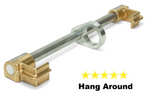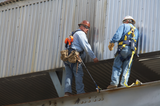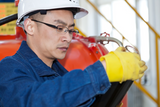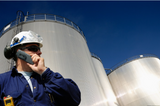Blog
I-Beam Anchorage for At-Height Workers
Recently a construction company contacted us to ask about using a
Miller Beam Anchor. They knew the anchor had the ability to provide anchorage for fall protection when used in a horizontal application. The 8816-14 from Miller is a typical beam anchor designed to provide an overhead attachment point on an I-beam or an H-beam. What they wanted to know was could they use the same product in on a vertical beam?
I'll keep the suspense to a minimum. Yes. Turns out Miller is perfectly happ
…
May 14th 2014
Class 2 Safety Clothing For Garbage Collectors
The need to be seen is especially important for workers who spend their days around moving traffic. Garbage collectors, utility workers, school crossing guards, and airport baggage handlers all fall into this category. These folks have specific safety precautions they are required to take under ANSI/ISEA 107-2004 which is the authoritative government tome on reflective and high-visibility clothing. But there are more options when meeting those standards than you might think.
This series of
…
May 12th 2014
Keeping Your ANSI Z359 SRLs Compliant
ANSI Z359.1 was published in 1992 and approved a scant 15 years later. Slowly grind the wheels of progress. And ANSI Z359 is progress in terms of worker safety, even if it is going to cost more money in the short run. Greater regulation of worker safety almost inevitably means increased administrative work and expense for employers, compliance provides improved safety for workers and increased protection against litigation. Certainly these are both worthy goals, whether you're working in the
…
May 7th 2014
H2S Monitor Bump Test: How Often Should My H2S Monitor Be Bump Tested?
A customer from the Chinese division of a large petroleum company emailed us this week to ask how often their
BW Clip H2S Monitors should be bump tested. Since we sell more of these monitors than any other at PK Safety Supply, it would seem logical that we'd have a ready answer. But we don't.
It's not because we don't care, or we don't think it's important. It is. Here's the situation: Officially, the manufacturer BW Honeywell recommends periodically testing the response of the hydro
…
Apr 28th 2014
Sunscreen Wipes: What’s Happening With the Sunscreen Towelettes?
While sunscreen towelettes are technically available through the end of this year, we've already sold out of these popular items. The folks who use them regularly are upset. Everybody loved those things. Easy application. You could keep 'em in your pocket. They might even survive one round in the washing machine. But as much as workers loved them, it wasn't enough for the new FDA regulations to keep them as approved delivery devices for
sunscreen. (Insert Bronx cheer here.)
As a safe
…
Apr 24th 2014
BW H2S Monitor Expiry: When is the Expiration Date for my Disposable BW Gas Monitor?
This is a great question about the
BW Clip Extreme H2S monitor, and I'm surprised we haven't had it before. A customer from our website asks "How long of a shelf life does the monitor have?"
The answer is each monitor has a unique turn-on date that is set one year after the manufacturing date. The warranty is tied to this manufacture date as well. BW provides a warranty for one year of shelf life plus the two years after activation.
If you have a monitor that is past its turn-o
…
Apr 14th 2014
Wireless QRAE 3 Confined Space Gas Detector from RAE Systems
RAE Systems is the manufacturer of the
QRAE 3, the newest multi-gas monitor for confined space entry. Up to four sensors can be configured in this device for combustible gases (LEL), Oxygen (O2), Carbon Monoxide (CO), Sulfur Dioxide (SO2), Hydrogen Sulfide (H2S), or Hydrogen Cyanide (HCN) depending on the specific needs of your facility.
The interesting thing about this monitor is the wireless configuration option. RAE Systems says this device will work in confined spaces as well. Fo
…
Apr 11th 2014
Klein Tools Means Quality No Matter What You Call Them
Klein Tools has been manufacturing tools for professional tradesmen for a very long time. And that might be part of the problem. Tower erectors, electricians, and telecom workers use their Klein tools every day, but the manufacturer and the users have very different names for the same products.
For example, here at
PK Safety we sell Klein Chicago Grips with about 50 variations in jaw shape and cable size accommodations. Chicago Grips? "What are those?" you might ask. My friends at PG
…
Apr 9th 2014
Oil & Gas Facilities Moving Toward Multi-Gas Monitors
As oil and gas production continues to expand in the United States and other countries, many companies are seeing the benefit of personal gas monitors that check for more than just hydrogen sulfide. Refineries, processing plants, pipelines, storage farms, and offshore platforms all use or create a wide range of toxic gases and dangerous atmospheres. While single gas monitors like the
BW Clip 3-Year Detector H2S are ubiquitous, they aren't capable of warning workers of all the changing cond
…
Apr 7th 2014
Inspection and Maintenance of Personal Protective Equipment
Personal protective equipment like
hard hats and harnesses aren't made to last forever. So much of this equipment has elastomeric or plastic parts that are particularly susceptible to deterioration over time. Abrasion can weaken stitching, nylon straps can be snagged and torn - even metal pieces corrode. Typically it's recommended by manufacturers that reusable PPE be replaced every 2-5 years even if it hasn't been damaged. But there are ways to extend the life of your PPE.
Safety eq
…
Apr 2nd 2014











